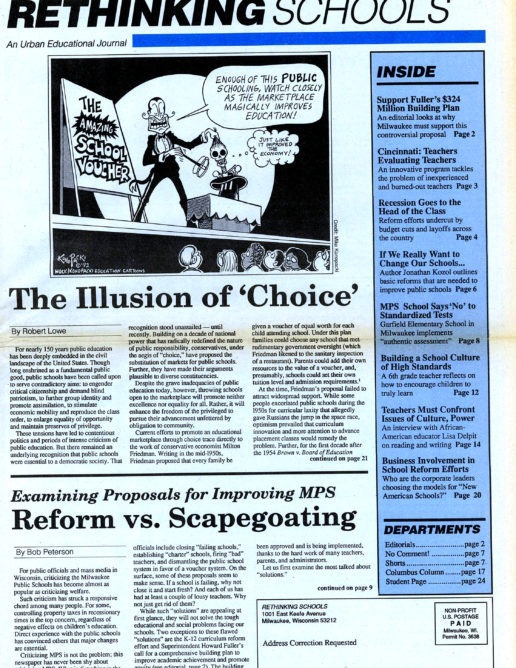Support Fuller’s $324 Million Building Plan
Classes held in corridors, special education students being taught in storage closets, schools without art or music rooms — these are just some of the appalling conditions that Milwaukee Public Schools Superintendent Howard Fuller hopes to remedy with his proposed $324 million building program.
The proposal is the first comprehensive assessment in over 22 years of the physical resources that MPS will need to educate its almost 100,000 students. Calling for smaller class sizes in many elementary grades and more resources for subjects such as computer science, art and music, it is an absolute precondition to making Milwaukee’s facilities equal to those in many suburban districts. This, in turn, is essential for any meaningful reform within MPS.
If this community is serious about ensuring a quality education for all its children, it will support the proposal. Despite the politicking that already surrounds the plan, it’s as simple as that.
The highlights of Fuller’s plan include:
- increasing the number of kindergarten classes to accommodate all eligible 4-year olds in half-day programs and all eligible 5-year olds in full day classes.
- reducing class sizes to 19 students in 1st and 2nd grade, and 24 students in 3rd through 5th grade.
- reducing by 50% the shortage of computer, art, music, and library rooms in elementary schools.
Fuller’s proposal had barely been released when it was immediately criticized as too costly — although no one argued with the proposal’s merits. The MPS task force that did the ground work on the plan, however, recommended a $1.2 billion plan that was far more comprehensive. In paring the figure down Fuller’s proposal does not call
for reducing kindergarten classes from the current maximum of 25 students. In addition, Fuller’s proposal calls for 50% of the kindergarten classes (158 classrooms) and 33% of the 1st through 5th grade classes (110 classrooms) to be “contracted through community organizations.” This was done in part to save money, because such sub-contracting would eliminate the need for building as many new schools. But will these vaguely defined “community organizations” have the space for such a large number of classrooms? Will the quality of the such private facilities and the yet-to-be-defined teaching arrangements promote equity and academic achievement?
Clearly, these questions must be addressed. Just as clearly, these are secondary concerns. The main focus must be on defending the plan from the intense election-year criticism it has received from politicians eager to win votes by bowing before the altar of fiscal conservatism. Our children need more classroom space and better facilities. To deny them these basics is unconscionable. Why don’t critics make similar complaints about other multi-million dollar capital projects such as the new Milwaukee County Jail and the seemingly endless deep-tunnel sewer project.
Much of the nay-saying has been led by Mayor John Norquist, who seems to spend more time on school issues than on much-needed economic development in Milwaukee. He instantly castigated the Fuller proposal as “way too much” and said it “must be scaled back.” (Perhaps he would like to scale it back so it is in line with his oft-stated view that we should completely “scrap” public schools in favor of a private voucher system.)
At this point, Fuller’s plan might go before the voters in a referendum in April 1993, after debate by the school board.
Supporters have a clear case that the facilities are needed. But in order to win voter approval, we must address the sincere concerns of financially pressed homeowners, especially those on fixed or low incomes.To do this successfully, we must challenge the status quo limitations of the debate, and push for more progressive taxes to fund schools and other social services.
Opponents complain that the Fuller proposal will increase property taxes. Why don’t they join those forces who want to make public schooling less dependent on property taxes? Why not demand increased state and federal aid to schools, funded by changes in current tax structures that benefit the rich and corporations? Why not help build the movement necessary to change federal budget priorities away from military spending and toward increased social spending?
Nor are such demands utopian. In some areas, they would merely require a return to the more progressive tax policies of the 1970s. Businesses in Wisconsin, for example, save as much as $1.1 billion a year due to tax breaks instituted since 1975. And while overall taxes on middle-income families have increased in the past six years, the wealthiest families in Wisconsin received a 14% tax cut.
Regardless of reform of state and federal tax structures, however, parents and teachers need to make clear to the community that Fuller’s plan is essential for meaningful school reform. If we can find the millions of dollars needed to build jails and sewers, why can’t we find the millions needed to give our children a quality education?

